Tihar, commonly referred to as the “Festival of Lights,” is the second most celebrated Festival in Nepal after Dashain. It is celebrated popularly in Nepal and India, but the level of merriment is absolutely the same. This festival is also widely known as Deepawali or Diwali. It is mostly celebrated by Hindus, and like any other festival, it has its own story to tell. It lasts five days, and one is as important as the other.
When is Tihar Festival 2025 date according to the Nepali Calendar and English date?
- Tihar Festival Date 2025: Sunday, Oct 19, 2025 – Thu, Oct 23, 2025
- Tihar Festival 2082 date according to Nepali Calendar: Sunday, Kartik 2, 2082 - Thursday, Kartik 06, 2082
Tihar Dates vary every year. For 2025, the Tihar festival will start earlier, from October 19 (Sunday, Crow Tihar, 2025) to October 23 (Thursday, Bhai Tika, 2025). As per the Nepali calendar, it will fall between Kartik 2nd (Kaag Tihar, Sunday, 2082) and Kartik 6th (Kartik 6, Thursday, Bhai Tika Tihar Date 2082) of the Nepali year 2082. The festival begins with Kaag Tihar on the first day and concludes with Bhai Tika on the last day. Tihar is celebrated shortly after Dashain, with only a few days separating these two grand festivals.
The auspicious time for Tihar's Bhai Tika in 2025 is 11:39 AM on Thursday, October 23. While state dignitaries should perform the ritual at this specific time, the general public can observe the ceremony in the afternoon without strict adherence to the auspicious hour. The main Tihar festival will run from October 19 to October 23.
Tihar festival 2025 in Nepal starts from today, according to the Nepali Calendar 2082.
In the festival of Tihar, animals such as Cows, Crows, and Dogs are given importance and worshipped. Each has its reasons for worship. Yet another deity, of course, is worshipped during this festival: Goddess Laxmi, the goddess of wealth and luck. This festival is termed the ‘Festival of Lights, ’ meaning each house is lit with electrical lights or, if not, Diyo, a clay lamp that uses oil.
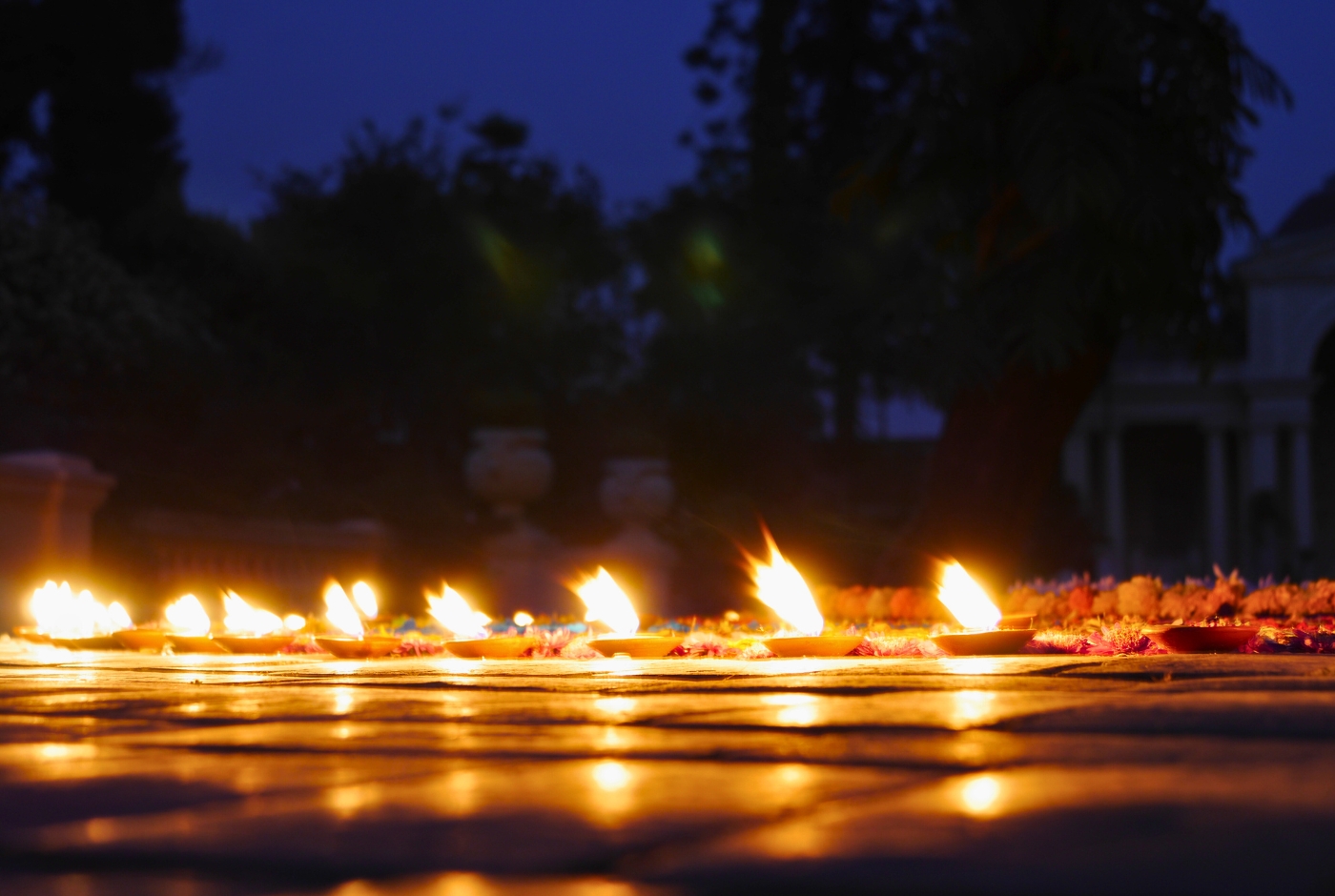
This article will discuss how and why and when Tihar is celebrated in Nepal.
Updated Tihar 2025 date and Time in Nepal: Tihar Festival with Kukur Tihar and Bhai Tika Tihar Date
Kaag Tihar date 2025: On Sunday, October 19, 2025—corresponding to 2082 Kartik 2 and Kartik Krishna Trayodashi in the Nepali calendar—Nepal observes Kag Tihar and Dhanwantari Jayanti. Kag Tihar, the first day of the five-day Tihar festival, honors crows as messengers of Yama, the god of death, by offering food on rooftops or outside homes.
Kukur Tihar and Laxmi Puja are on the same date this year, 2025: On Monday, October 20, 2025—corresponding to 2082 Kartik 3 (according to Nepali calendar) and Kartik Krishna Chaturdashi, Nepal observes several significant occasions. The day is widely celebrated as Laxmi Puja, the most important day of the Tihar festival, where households light oil lamps and worship Goddess Laxmi for prosperity and well-being. It also marks Kukur Tihar, a unique celebration honoring dogs for their loyalty and spiritual connection with Yama, the god of death. Additionally, the day commemorates the birth anniversary of Mahakavi Laxmi Prasad Devkota, Nepal’s greatest literary figure.
Tuesday, October 21, 2025, corresponding to 2082 Kartik 4 and Kartik Krishna Aunsi, is observed as the official Tihar Holiday in Nepal. While there are no specific rituals on this date, it serves as a day of rest, family gathering, and reflection after the vibrant festivities.
Gai Puja, Goru Puja, Govardan Puja date of Tihar 2025: Wednesday, October 22, 2025, which falls on 2082 Kartik 5 and marks Kartik Shukla Pratipada, is celebrated across Nepal with multiple important festivals. The day features Govardhan Puja, honouring Lord Krishna’s lifting of Mount Govardhan to protect villagers from torrential rain. It is also observed as Gai Puja and Goru Puja, where cows and oxen are worshipped for their sacred and agricultural roles. In the Newar community, this day is especially significant as they perform Mha Puja, a self-purification ritual marking the beginning of a new spiritual year.
Bhai Tika 2025 date and Time according to the Nepali calendar: Thursday, October 23, 2025, which corresponds to 2082 Kartik 6 and Kartik Shukla Dwitiya, is celebrated as Bhai Tika across Nepal. It is the final and most emotionally significant day of the Tihar festival, where sisters offer tika, garlands, and blessings to their brothers for a long life and protection. In return, brothers give gifts, money, and promises of lifelong support. Among the Newar community, the ritual is known as Kija Puja, with unique customs and spiritual symbolism. Bhai Tika is a celebration of sibling love, protection, and family unity, deeply rooted in Nepali tradition and widely observed across the country.
Bhai Tika Tihar 2025 Date and Auspicious Time to Apply Tika
Bhai Tika, the final and most cherished day of Tihar 2025, celebrates the sacred bond between brothers and sisters. Observed on 6th Kartik 2082 (23 October 2025) in Nepal, this auspicious day symbolizes protection, blessings, and family unity. Sisters apply the tika of seven colors, offer garlands, and pray for their brothers’ long life, while brothers express gratitude through heartfelt gifts. For Nepalis living abroad, knowing the exact Bhai Tika time helps preserve this emotional tradition across time zones. Below is the Bhai Tika 2025 auspicious local time and date for major cities worldwide.
Tihar 2025: Bhai Tika Date and Time Around the World
| Country / City | Tihar Tika Date (Local) | Tihar Auspicious Time |
|---|---|---|
| Tihar in Kathmandu, Nepal | 6th Kartik 2082 (23 Oct 2025) | 11:39 AM |
| Tihar in Delhi, India | 23 Oct 2025 | 11:55 AM |
| Tihar in New York, USA | 22 Oct 2025 | 11:45 AM |
| Tihar in Texas, USA | 22 Oct 2025 | 11:57 AM |
| Tihar in Washington DC, USA | 22 Oct 2025 | 11:41 AM |
| Tihar in California, USA | 22 Oct 2025 | 11:49 AM |
| Tihar in Chicago, USA | 22 Oct 2025 | 11:33 AM |
| Tihar in Toronto, Canada | 22 Oct 2025 | 11:23 AM |
| Tihar in Vancouver, Canada | 22 Oct 2025 | 11:35 AM |
| Tihar in Sydney, Australia | 23 Oct 2025 | 11:25 AM |
| Tihar in Melbourne, Australia | 23 Oct 2025 | 11:35 AM |
| Tihar 2025 in Brisbane, Australia | 23 Oct 2025 | 11:43 AM |
| Tihar in Adelaide, Australia | 23 Oct 2025 | 11:53 AM |
| Canberra, Australia | 23 Oct 2025 | 11:27 AM |
| Tasmania, Australia | 23 Oct 2025 | 11:25 AM |
| Perth, Australia | 23 Oct 2025 | 10:34 AM |
| Darwin, Australia | 23 Oct 2025 | 11:57 AM |
| Wellington, New Zealand | 23 Oct 2025 | 11:31 AM |
| Lisbon, Portugal | 23 Oct 2025 | 11:29 AM |
| London, England | 23 Oct 2025 | 11:37 AM |
| Paris, France | 23 Oct 2025 | 11:21 AM |
| Oslo, Norway | 23 Oct 2025 | 11:43 AM |
| Denmark | 23 Oct 2025 | 11:25 AM |
| Germany | 23 Oct 2025 | 11:43 AM |
| Finland | 23 Oct 2025 | 11:47 AM |
| Geneva, Switzerland | 23 Oct 2025 | 11:45 AM |
| Malta | 23 Oct 2025 | 11:23 AM |
| Kuala Lumpur, Malaysia | 23 Oct 2025 | 11:57 AM |
| Abu Dhabi, UAE | 23 Oct 2025 | 11:45 AM |
| Doha, Qatar | 23 Oct 2025 | 11:55 AM |
| Kuwait | 23 Oct 2025 | 11:45 AM |
| Tel Aviv, Israel | 23 Oct 2025 | 11:01 AM |
| Saudi Arabia | 23 Oct 2025 | 11:55 AM |
| Bangkok, Thailand | 23 Oct 2025 | 11:41 AM |
| Tokyo, Japan | 23 Oct 2025 | 11:42 AM |
| Seoul, South Korea | 23 Oct 2025 | 11:21 AM |
| Singapore | 23 Oct 2025 | 11:58 AM |
| Hong Kong | 23 Oct 2025 | 11:45 AM |
| Yangon, Myanmar | 23 Oct 2025 | 11:55 AM |
Why is the Tihar Festival celebrated?
Tihar is celebrated to honor the Hindu deities Lakshmi (goddess of wealth) and Yama (god of death), and to show gratitude to animals like crows, dogs, and cows for their vital roles in human life and the agricultural cycle. The five-day festival, also known as the Festival of Lights, symbolizes the victory of light over darkness and fosters spiritual reflection, family bonds, and prosperity within homes and the community.
As with other Nepali festivals, Tihar also holds vast cultural and religious meanings embedded in the principles of Hinduism. It has evolved from various myths and legends that include the supremacy of the good spirit over the evil spirit, the family values, and the culture of honoring animals and trees. Here are some of the history and background of Tihar Festival:
Goddess Laxmi: Goddess of wealth and good fortune
One of the most significant components of this festival is the worship of the goddess of wealth, Laxmi. During Tihar, and more significantly during the third day or Laxmi Puja, she enters the houses to bring fortunes. Oil lamps and candles help her light up the homes, symbolizing the victory of light over the dark.
Yama and his Messengers
Tihar also encompasses rituals of worshipping Lord Yamaraj, also known as the god of death. Crows and Dogs are thus believed to be the messengers of Yama. They are worshipped during the Kaag Tihar and Kukur Tihar festivals to please the god of death, Yama, and avoid dying before time.
Krishna and the Gobardhan Hill
On the fourth day, Gobardhan Puja has its origin based on the mythology about Lord Krishna, who lifted a hill on one finger. He did so for his fellow villagers to avoid angering Indra, the rain god, and being frustrated by consistent showers. This day also tells the superiority of Lord Krishna, especially over Indra, and the importance of Gobardhan Hill.
Festival of colors and flowers - Tihar 2025
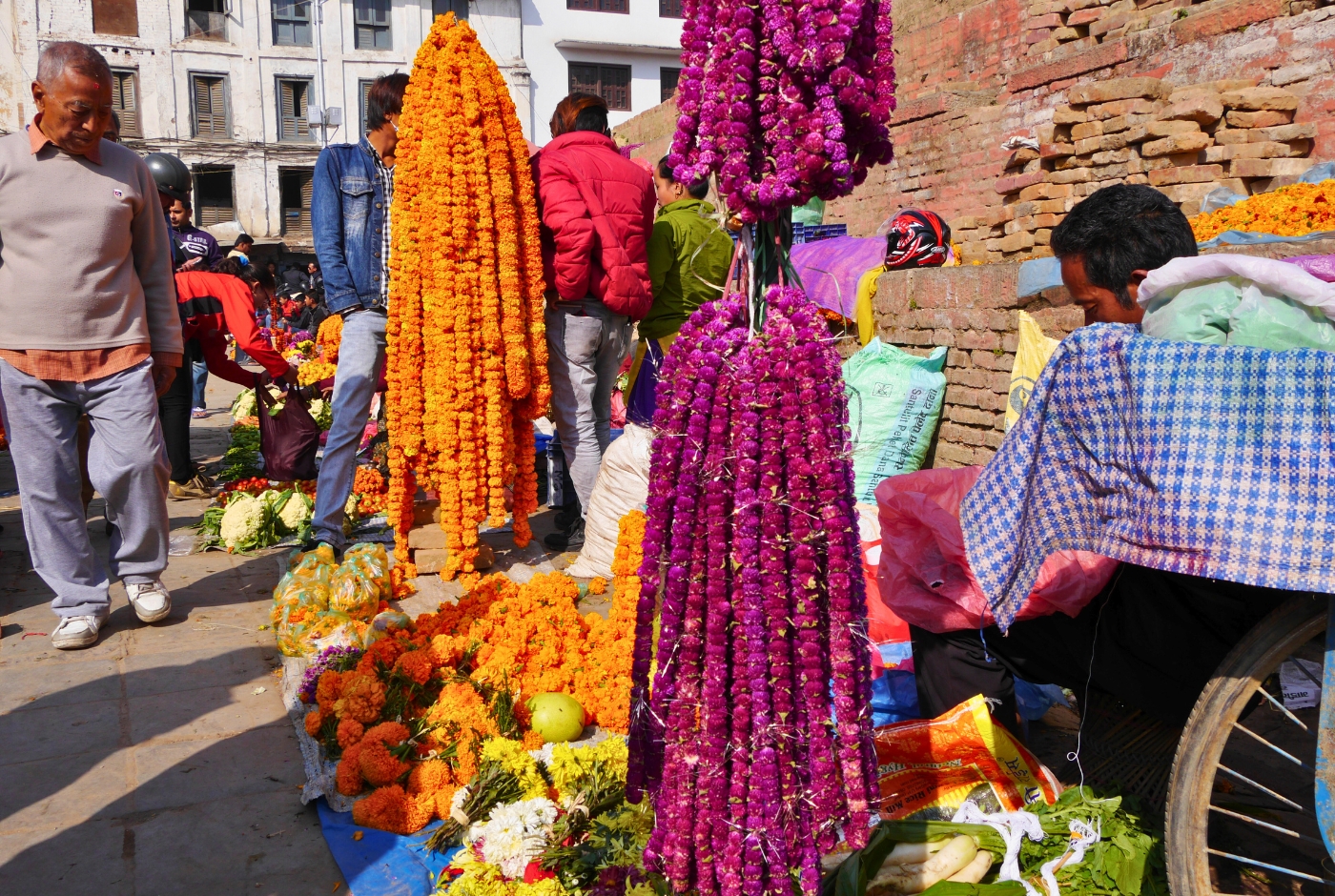
Newari culture of Mha: Puja
That is why the Tihar festival is celebrated with great enthusiasm in Nepal, particularly by the Newari community. It is the same as the Newari New Year called Nepal Sambat. The fourth day of Tihar is celebrated as Mha: Namaste, which is a form of prayer symbolizing self-worship and giving power to the soul. This signifies the cultural and religious endowment of the Newar people in celebrating Tihar.
Nighttime view during Tihar Festive
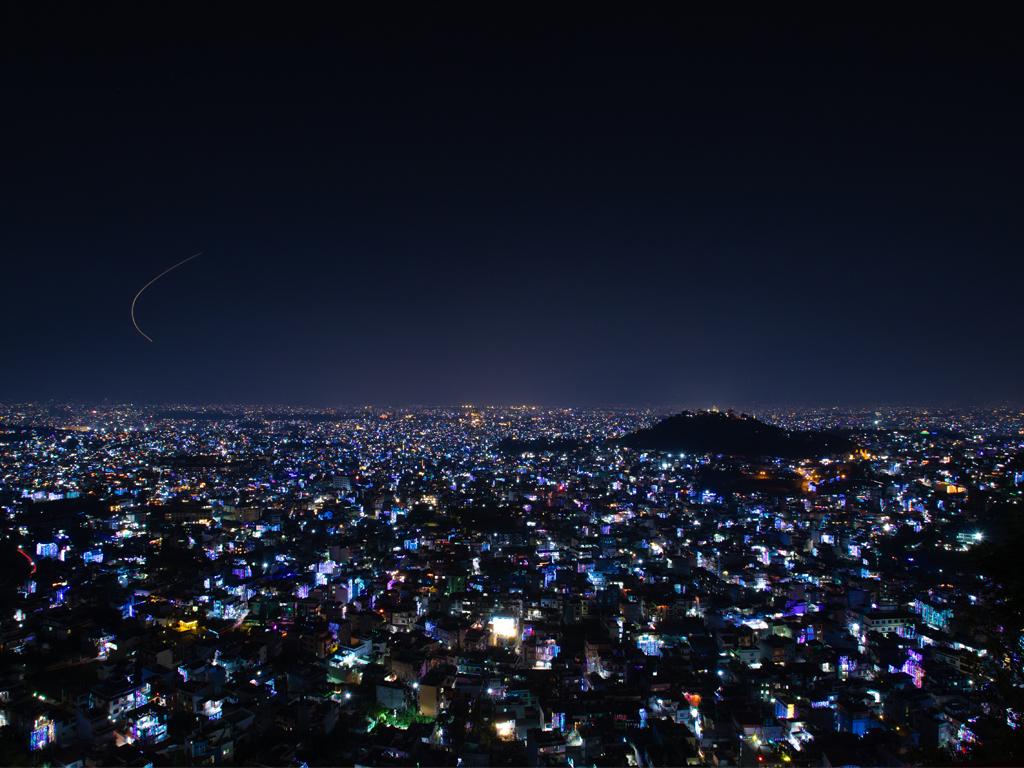
How is Tihar 2025 Celebrated in Nepal?
Tihar is a festival that is celebrated for five days. Most Nepalese celebrate it by cleaning their house, buying new ornaments and utensils, and decorating their beautiful house, too. Every house is full, lively, and decked up for Tihar with new clothes, gifts, sweets, and flowers. At night, the houses are illuminated by traditional diyo and small colored clay lamps. These lamps are lit as a beacon to invite Goddess Laxmi into the house and seek her blessings. Groups of young girls and boys come singing Deusi and Bhailo which are, in fact, mere expressions of sweetness where they only wish well for the house and the family.
Kaag Tihar:
The first day of Tihar is Kaag Tihar (19th October, 2025/ 2nd Kartik, 2082 on Sunday). Kaag refers to crow and is considered to be a bearer of bad news in the Nepali context. On this day, black crows are fed and worshipped by offering them grains like rice, water, sweets, sel roti, puri tarkari, and grains on rooftops (terraces, or courtyards) before sunrise to ward off sorrow and misfortune. This is done to ensure they are happy and have no devastating news to share in the future. Some believe buying new household items, gold, or silver on this day is auspicious for bringing good luck and prosperity.
When is Kaag Tihar 2025?
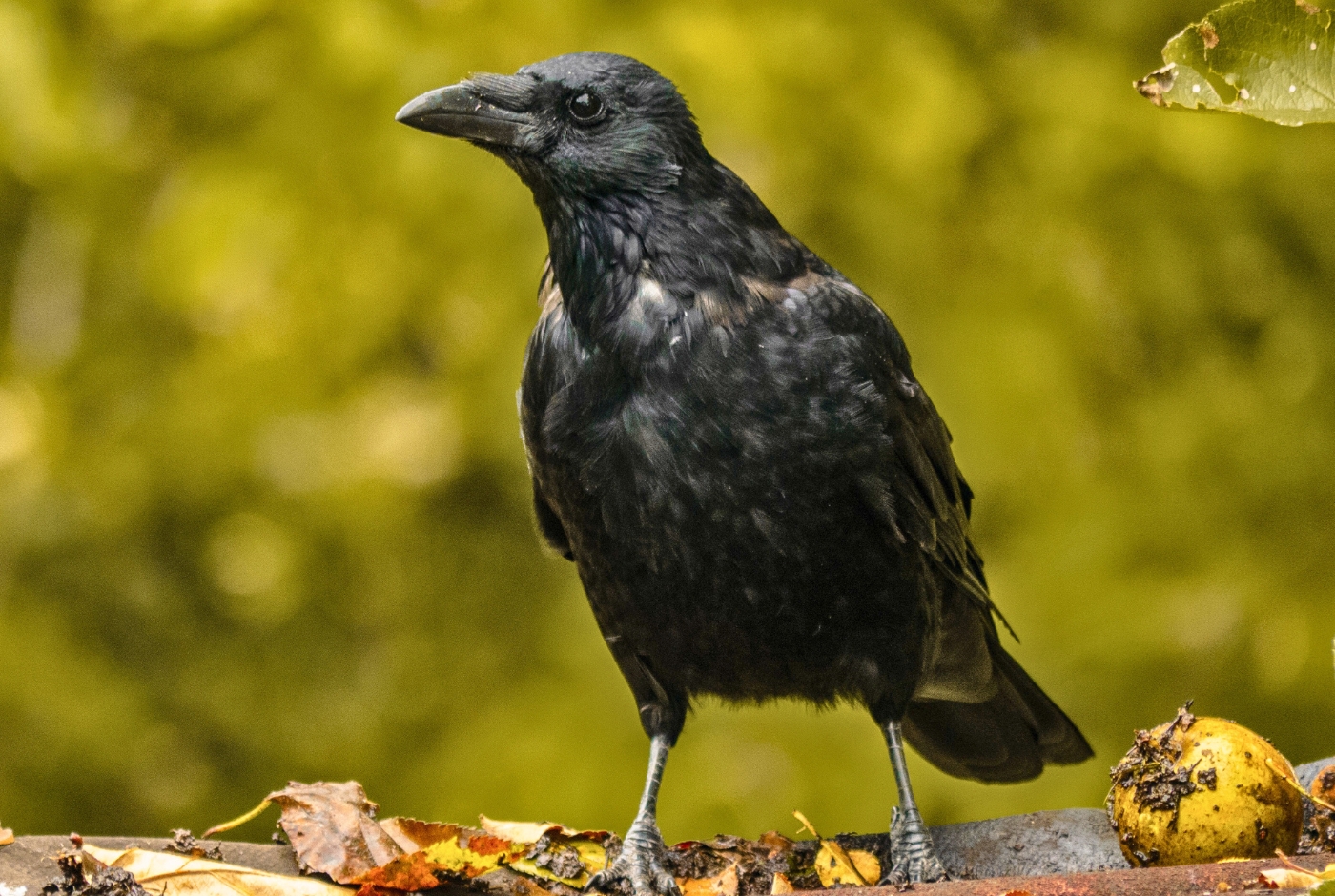
Kukur Tihar 2025:
The second day of the festival is known as Kukur Tihar (20th October 2025/ 3rd Kartik, 2082, on Monday), or ‘the day of the dogs.’ Kukur is the term for dogs, and they are mentioned to be the ‘guardian and the guide of the souls’. They are fed good food (dog food, meat, eggs and others), and their owners place garlands of red and yellowish marigolds around their necks and apply red tika on their foreheads. People often gather in streets and parks to celebrate together, reinforcing the bond between humans and dogs and creating a joyful atmosphere.
Kukur Tihar 2025: Nepal Dog festival 2025
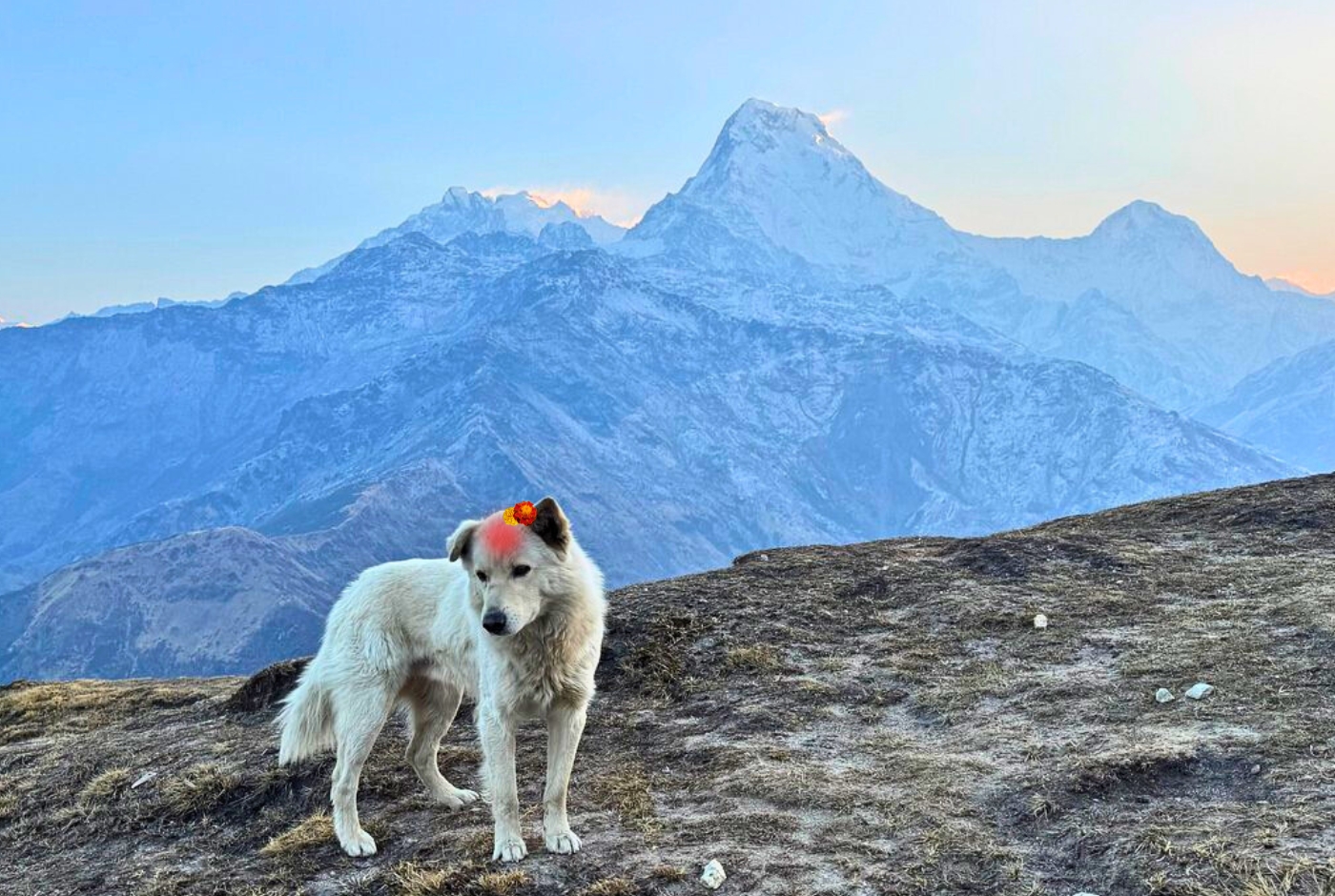
Gai Puja/ Laxmi Puja:
On the third day (21st October 2025/ 4th Kartik, 2082, Tuesday), they perform Gai Puja "Gai Tihar" and Laxmi Puja. Gai Puja is the worship of cows and is referred to as Gau worship. Similar to dogs, cows are offered grass and worshipped, and people put garlands around them and ‘tikas’ on their heads. Cows are symbols of prosperity, and hence, to invite good prosperity, they are even worshipped. During Gai Tihar, families decorate cows with garlands of marigolds, apply tika (a mark on the forehead), and offer them their favorite grass and delicacies to show gratitude and seek blessings.
To invite prosperity and good fortune, people also tie the sacred thread (Janai or Raksha Bandhan thread), previously used during Janai Purnima, to the cow’s tail, symbolizing purity, protection, and blessings for the household.
Gai Puja ana Laxmi Puja 2025 Tihar
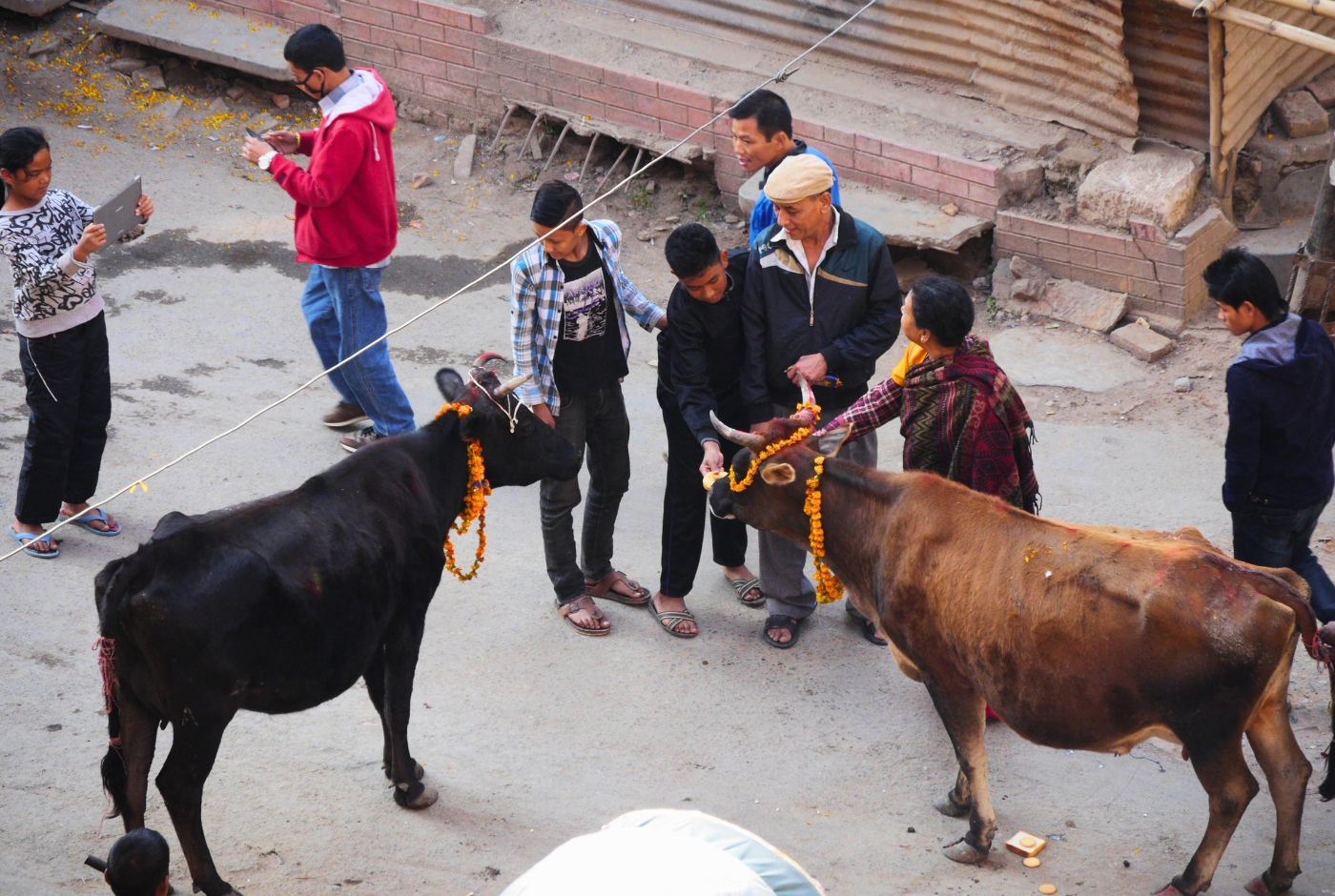
After that, people get ready for Laxmi puja. Chores are done, diyos are lit, lights are hung on the house, and everybody congregates for night prayers. Goddess Laxmi is worshipped, and in front of the picture of the Laxmi statue or frame, people put sweets, fruits, and Sel roti (sweet rice bread). The young boys and girls also go to play Deusi-Bhailo after the puja is performed.
Laxmi Puja in Nepal is the central event of the Tihar festival's fourth day (however, this year it is on the third day), when people honor Goddess Lakshmi, the goddess of wealth and prosperity. Celebrations include cleaning and illuminating homes with candles and lights, decorating with marigolds and making rangoli at entrances, and performing a ritual puja with offerings. The day is also known for the start of the Deusi-Bhailo tradition, where people sing and dance while going door-to-door for blessings and to receive gifts. Homes are cleaned by a mixture of cow dung and red mud (rato mato). A colorful rangoli or mandala is created in the front yard of the house by using a mixture of colors, rice, flour, or flower petals. A small footprint made of flour and red color powder is drawn from the entrance gate to each room and the main altar to symbolize the goddess's arrival. Foods such as bhaja "tarkari", sel roti, khichuri, sweets, aachar, are prepared and offered to the goddess.
Laxmi Puja Tihar 2025 Date in Nepali Calendar
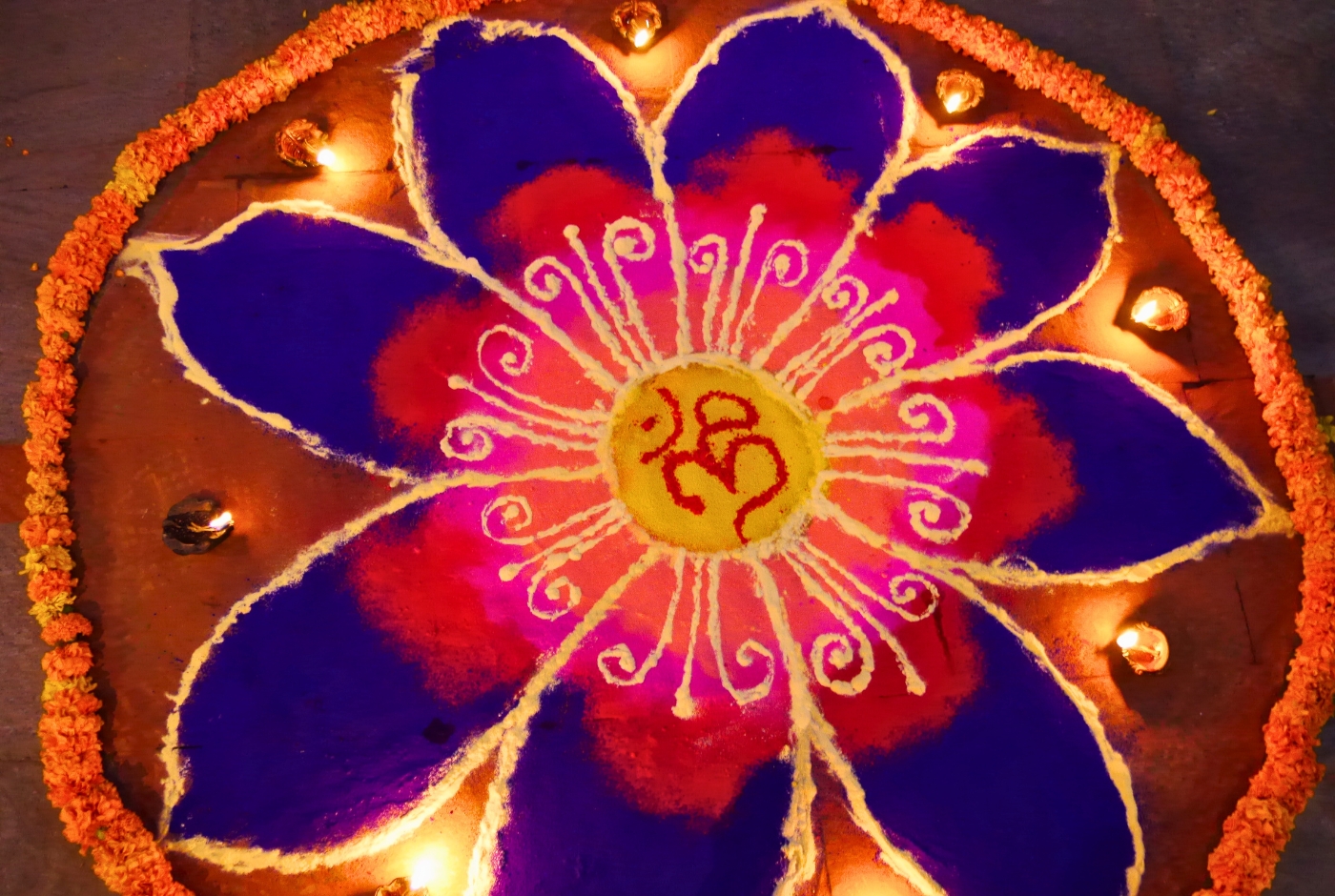
Govardhan Puja/ Mha Puja:
The next animal worshipped in Tihar is the Ox (22nd October 2025/ 5th Kartik, 2082, Wednesday), celebrated on the fourth day of Tihar in Nepal. They are considered to be of so much importance in domestic animals, particularly to the farmers. The oxen are treated with so much respect and have full bowls of fresh grass in front of them to eat.
Tihar Festival worship Pictures
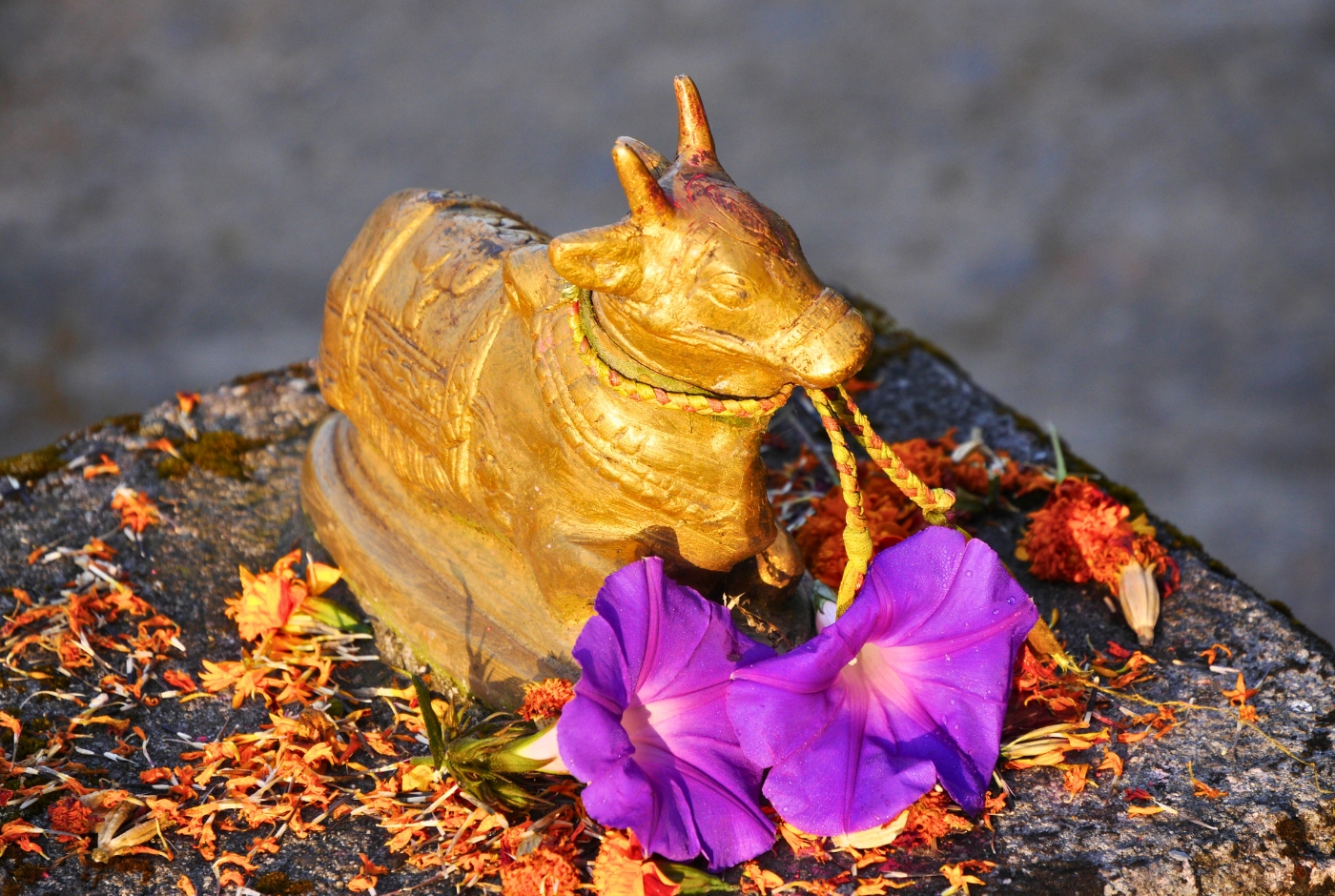
Apart from this day, Mha Puja is also celebrated by the Newari community of Nepal. It is a Newari New Year for this community, which they celebrate happily. They dress up in new clothes, invite friends and relatives over and celebrate the New Year. The tradition of Deusi-Bhailo (singing and dancing groups) also continues on this day, with participants being rewarded with money and sweets.
Bhai Tika 2025 Nepal:
Bhai Tika is the last day of Tihar. This day celebrates brothers and sisters’ love for one another. On Kartik 6th day (6th of Kartik Bhai Tika date 2082), sisters dress up, cook, and pack the tika and garlands. At the same time, the brothers also transform themselves in their formal attire and purchase gifts for the sisters. There is an agreed time fixed by the priest at which the time of the ceremony starts. Firstly, the sister applies a tika, which has a white base and then seven different colors on the forehead. After this, they put new garlands around their necks; they make them eat Sel roti, milk, and sweets. Bhai Tika Tihar, in 2025, is being celebrated at 23rd October (Kartik 6th, 2082, Thursday).
These are the ways Nepalese celebrate Tihar. The festival is loved by everyone, and you can enjoy it in Nepal. One can enjoy the melodious voices of youths and the lovely cooking smell of sel roti. During this festival, sisters apply a seven-colored "saptarangi" tika on their brothers' foreheads, offer them garlands, and present gifts and sweets to wish them long life, prosperity, and protection. In return, brothers offer gifts like money and clothes to their sisters and may also apply a tika to them.
In cases where individuals do not have a brother or sister, they go to the Ranipokhari Temple in Kathmandu to receive a tika there.
Bhai Tika Tihar, Nepal
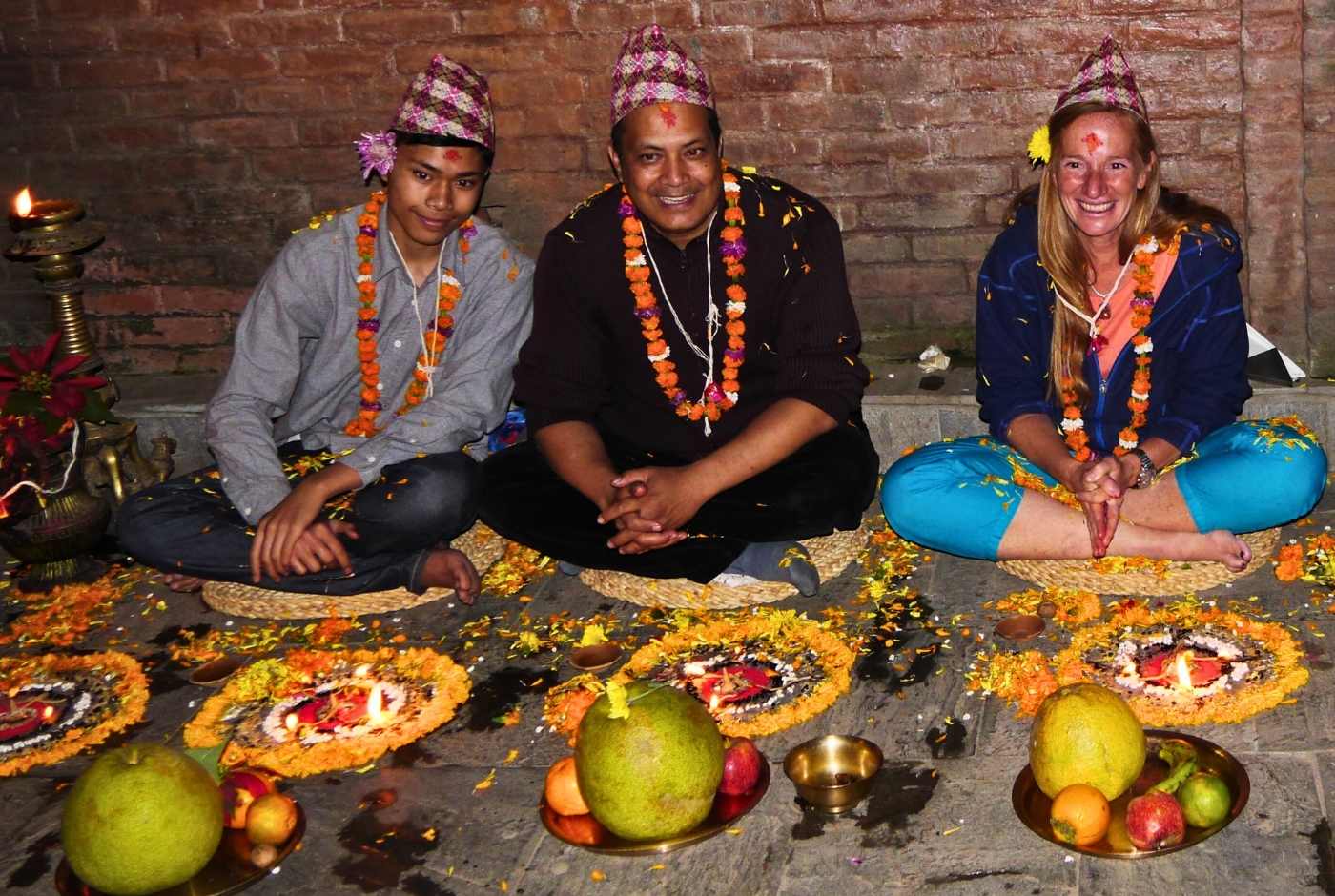
Why Tihar is Called Yama Panchak
Tihar, also known as Deepawali or the Festival of Lights and Flowers, is a five-day Hindu celebration uniquely observed in Nepal. It is also called Yama Panchak because each day is symbolically connected to Yama, the god of death, and his sister Yamuna. The term combines “Yama” (god of death) and “Panchak” (meaning "five"), signifying the five sacred days of rituals and worship.
The mythological roots of Tihar highlight a touching bond between siblings. One widely told legend speaks of Yamuna, deeply worried about her brother's declining health. In her devotion, she performed rituals and prayers to Yama, asking for his mercy. Moved by her love and faith, Yama granted her wish, blessing her brother with long life. Another version narrates how Yamuna sent symbolic messages to Yama through animals—crows, dogs, and cows—before finally reuniting with him on the fifth day, which inspired the Bhai Tika tradition. On this final day, sisters apply tika to their brothers' foreheads, offer garlands and sweets, and pray for their protection and longevity.
Each day of Yama Panchak honors a different sacred being—Kag Tihar (crows), Kukur Tihar (dogs), Gai Tihar (cows), Govardhan/Mha Puja, and Bhai Tika—all tied to spiritual symbolism and the themes of death, protection, gratitude, and familial love. This deep connection to Yama and Yamuna makes Tihar a celebration not only of lights and prosperity but also of devotion, kinship, and the cycle of life.
Can you make travel plans during the festive time in Nepal?
The Festival of Tihar is in November, which is a peak trekking season, so you can freely hike or trek. You'll appreciate Nepali culture more deeply while exploring the country's stunning beauty. Without a doubt, the best time to trek is between October and November. Do you know why? The monsoon will have been gone by then, and the skies will be clearer than ever, along with Nepal's biggest festival, Tihar. In Tihar, there will be 3 to 5 days of public holiday in Nepal. During this time, businesses, schools, and government offices remain closed, allowing people to celebrate the festival with family and community.
Even the trails would be perfectly dry for hassle-free trekking and mesmerizing mountain views. Whether you want a short hike or choose any of our trekking packages, the time during Tihar would be flawless. So book your next trekking adventure, like Everest Base Camp Trek or Annapurna Base Camp Trek, and get mesmerized by the mountains.
You’ll also get to see the true cultural harmony between people. You can get the Best of Nepal during this time of year. You can see devotees lining up for worship. The weather and vibes are festive, with mantras being chanted all around. The festivities surrounding these temples are not explainable as devotees pay their respect and pray. So, don't hesitate to join a festival time in your travel plans!
When was Tihar 2024? Tihar date 2024 and when was Bhai Tika 2024
According to the calendar, in 2024, the Tihar festival will be celebrated from 30th October to 3rd November. In the Nepali calendar, it was from 14th Kartik to 18th Kartik, as per the ongoing Nepali calendar 2081. Kaag Tihar is the first day, while Bhai Tika is the last day of the occasion. Tihar is celebrated right after Dashain, with only a few days' difference between the two biggest festivals.
Kukur Tihar 2024: When was Kukur Tihar 2024?
Kukur Tihar in 2024 was celebrated on October 31st. It is the second day of the five-day Tihar festival in Nepal, a time when dogs are honored and given special attention, including garlands and treats.
Kukur Tihar and Laxmi Puja date 2023: When was Kukur Tihar and Laxmi Puja celebrated in 2023?
In 2023, Kukur Tihar, the second day of the Tihar festival, was celebrated on November 11th. Tihar itself began on November 10th and ended on November 14th. This festival is a time to honor dogs for their loyalty and companionship.
In 2023, Lakshmi Puja in Nepal, also known as Gai Tihar and Laxmi Puja, was celebrated on November 12th. This is the third day of Tihar, a five-day Hindu festival celebrated after Dashain. On this day, cows are worshiped in the morning, and Goddess Lakshmi is offered elaborate prayers and puja in the evening.
How many days are left for Tihar 2025?
Today, 23rd October (Kartik 6 2082 B.S) concludes the end of Tihar 2025.
The dates for Tihar 2025 were,
Day 1 (Kaag Tihar): Sunday, October 19
Day 2 (Kukur Tihar & Laxmi Puja): Monday, October 20
Day 3 (Gai Tihar): Tuesday, October 21
Day 4 (Goru Tihar & Mha Puja): Wednesday, October 22
Day 5 (Bhai Tika): Thursday, October 23 (being celebrating)
What are the 5 days of Tihar?
The five days of Tihar are Kaag Tihar (Crow Day), Kukur Tihar (Dog Day), Gai Tihar and Laxmi Puja (Cow Day and Goddess of Wealth worship), Govardhan Puja (Oxen Worship), and Bhai Tika (Brother-Sister Day). The festival is Nepal's second-largest celebration, known as the festival of lights, and honors animals, light, and human bonds.
Conclusion:
Visit Nepal in October 2025 and enjoy Tihar with us, the Nepal Hiking Team. We would love to have you with us on this joyful occasion. You will be able to experience Kathmandu's roads and see the city through the eyes of Nepalese people based on the vibrant cultural influences.



Post a Comment